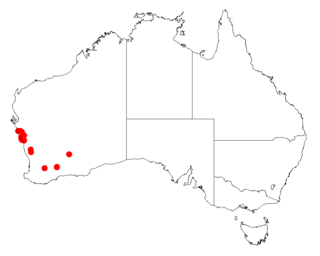
Acacia spondylophylla, commonly known as curry wattle or spine-leaf wattle, is a small, flat topped shrub native to central and western Australia. The leaves, which are arranged on spaced whorls around the stem, have a distinctive curry-like smell.

Acacia gloeotricha is a shrub belonging to the genus Acacia and the subgenus Juliflorae that is endemic to north western Australia.

Acacia hilliana, commonly known as Hill's tabletop wattle but also known as sandhill wattle and Hilltop wattle, is a shrub belonging to the genus Acacia and the subgenus Juliflorae. It is native to northern Australia.

Acacia inophloia, commonly known as fibre-barked wattle, is a tree or shrub belonging to the genus Acacia and the subgenus Juliflorae that is native to Western Australia.
Acacia claviseta, also known as the club-tipped whorled wattle, is a shrub belonging to the genus Acacia and the subgenus Lycopodiifoliae that is endemic to north western Australia.

Acacia hippuroides is a shrub belonging to the genus Acacia and the subgenus Lycopodiifoliae that is endemic to north western Australia

Acacia glutinosissima is a shrub belonging to the genus Acacia and the subgenus Phyllodineae that is endemic to western Australia.

Acacia gonophylla, also known as rasp-stemmed wattle, is a shrub belonging to the genus Acacia and the subgenus Phyllodineae that is endemic to south western parts of Australia.

Acacia oxyclada is a shrub belonging to the genus Acacia and the subgenus Phyllodineae that is endemic to western Australia.

Acacia rossei, also known as Yellowdine wattle, is a shrub of the genus Acacia and the subgenus Phyllodineae that is endemic to south western Australia.

Acacia sessilis is a shrub of the genus Acacia and the subgenus Phyllodineae that is endemic to south western Australia.

Acacia spinosissima is a shrub of the genus Acacia and the subgenus Phyllodineae native to south western Australia.

Acacia ascendens is a shrub of the genus Acacia and the subgenus Plurinerves that is endemic to a small area in south western Australia.

Acacia campylophylla is a shrub of the genus Acacia and the subgenus Plurinerves that is endemic to a part of south western Australia.

Acacia colletioides, commonly known as wait-a-while, pin bush and spine bush, is a shrub of the genus Acacia and the subgenus Plurinerves that is native to Australia.

Acacia loxophylla is a shrub of the genus Acacia and the subgenus Plurinerves that is endemic to an area of south western Australia.
Acacia manipularis is a shrub of the genus Acacia and the subgenus Plurinerves that is endemic to north western Australia.

Acacia gladiiformis, commonly known as sword wattle or sword-leaf wattle, is a shrub belonging to the genus Acacia and the subgenus Phyllodineae that is native to parts of eastern Australia.
Acacia gracillima is a shrub or tree belonging to the genus Acacia and the subgenus Juliflorae that is native to north western Australia.

Acacia viscidula, also known as sticky wattle, is a shrub of the genus Acacia and the subgenus Plurinerves that is endemic to an area of eastern Australia.


















